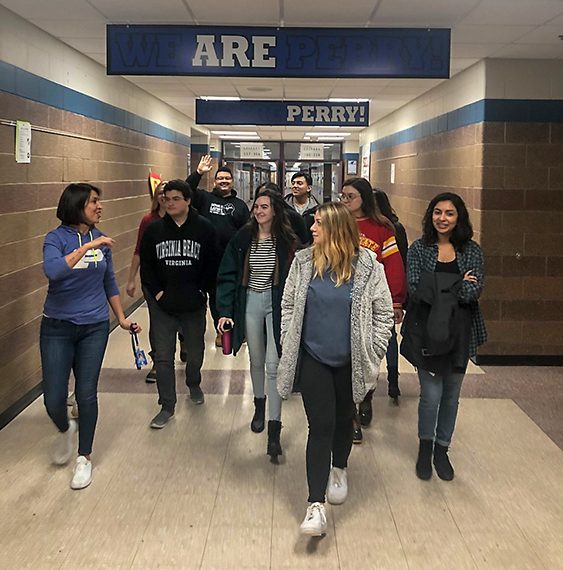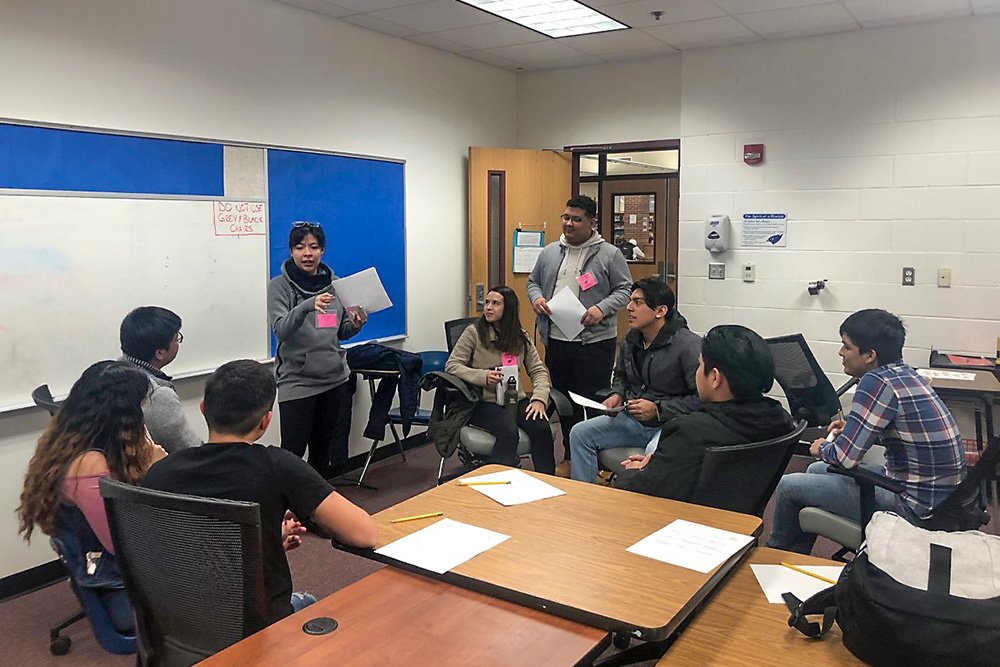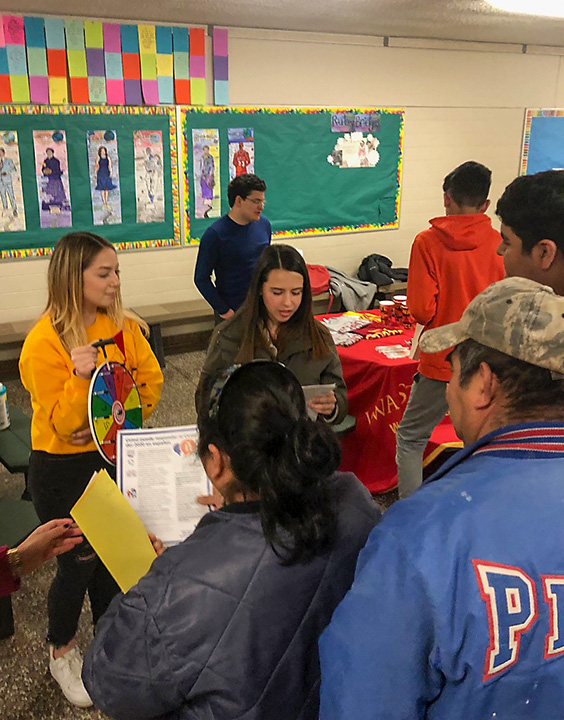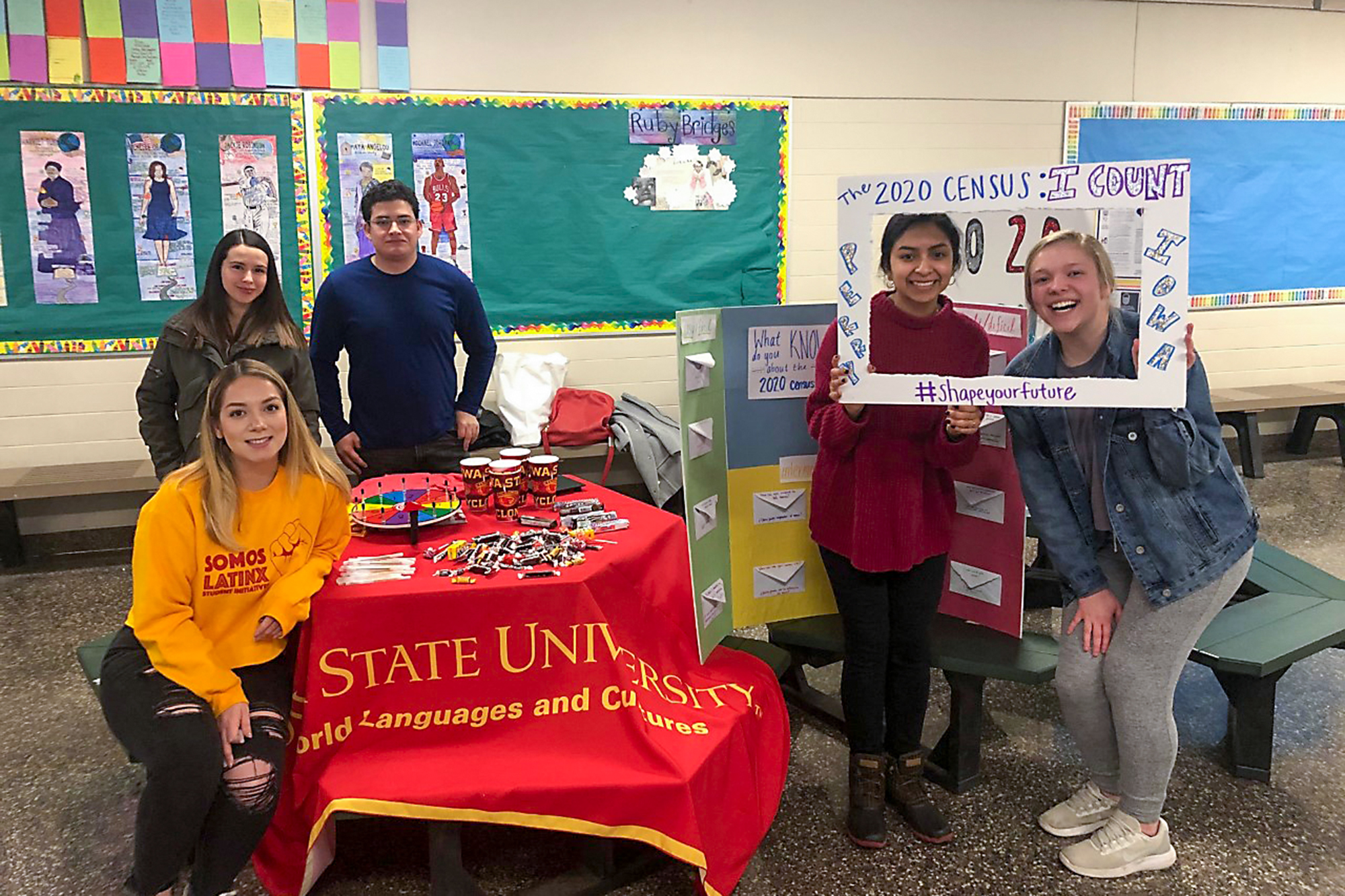Before Iowa State’s spring classes moved online to minimize the spread of the novel coronavirus, Jennifer Nuñez was already engaged in a unique kind of learning this semester.
Every other Friday, she and her classmates had been loading up in a 15-passenger van for a nearly hour-long drive west on Highway 30 to Perry High School in Perry, Iowa.
Nuñez (‘21 women’s and gender studies) and her peers are part of USLS 325: Iowa Latinx and the Immigration Experience. Funded by a Miller Family Faculty Fellowship and taught by Megan Myers, assistant professor of Spanish in the Department of World Languages and Cultures, the service-learning class is in its second year.
The course centers on a unique partnership with the Perry Community School District.
“Last year we focused on academic success tips and college prep,” Myers said. “We decided this year instead of doing a partnership model we would move to a project-based model, so we could build on the knowledge and creativity of the Perry students and the Iowa State students working together.”
"The students are engaged and excited because they know there is a community engagement component,” Myers said. “It’s a really diverse class in many ways and it’s extremely interdisciplinary."
This semester, Iowa State and Perry students have been collaborating on a 2020 bilingual census outreach project for the community. Fortunately, they completed the majority of their in-person work early in the semester—and those efforts will have a positive impact this spring.
Community impact
Perry Community School District, located about 25 miles northwest of Des Moines, has seen a dramatic shift in demographics since Angélica Díaz-Cárdenas was a high school student in 1996.
“When I first started at Perry High School, I was in 10th grade,” said Díaz-Cárdenas, Perry High School’s guidance counselor. “I was one of five or six students who were English as a Second Language students. Out of those, four of them were family members of mine. There were other Latino students in the school, but they were coming mainly from California so they spoke English.”
Now 50% of Perry High School’s 600 students are from a minority background, said Díaz-Cárdenas. Many identify as Latino, with backgrounds from Guatemala, Mexico, Nicaragua or Honduras.

Myers co-chairs a Center for Excellence in the Arts and Humanities-funded Iowa State faculty learning community that focuses on community engagement and public scholarship in Perry. When Myers and Department of World Languages and Cultures advisor Flor Romero de Slowing approached Díaz-Cárdenas about doing a census project, the counselor was immediately excited about its potential community impact.
“Even if we are only able to educate our students here, they can tell their parents,” Díaz-Cárdenas said. “If someone from the census comes to their door at home, the students can say, ‘Mom, we talked about this in school,’ and they can also tell their friends.”
Learning together
During the start of the semester, Nuñez and her classmates toured the high school and began working on lesson plans for each session, including dividing up speaking roles.

“We see who is willing to speak in Spanish and who is willing to speak in English,” she said. “All the students are English as a Second Language students and we’re very conscious that not all the students are Spanish speakers.”
One lesson included designing games that students could share at Perry’s parent-teacher school conferences to help their families understand the importance of being counted in the census and the different ways to participate in it.
“We want to help students educate their parents, so their parents can feel more comfortable with the census,” Nuñez said.

Nuñez said she is learning alongside her high school counterparts, and also from them, as she seeks not to make assumptions about what people do or do not know.
“I asked one of the students ‘Do you know what the census is?’ as a general question and he said, ‘Yes, we also do a census in Mexico,’” she said. “I didn’t know that, but it makes sense. We’re learning with and from each other.”
Thinking critically about identity
Myers’ syllabus is co-created by her students and based on their interests.
“The students are engaged and excited because they know there is a community engagement component,” she said. “It’s a really diverse class in many ways and it’s extremely interdisciplinary. We have students who are in community and regional planning, agriculture, Spanish education and in lots of roles and positions on campus. It’s an amazing class for a lot of reasons.”
Her class wanted to study rhetoric from high-profile events such as the 2008 immigration raid in Postville, Iowa, as well as the history of Latinx immigration in Iowa. This year, they are also using the census to discuss issues of race and ethnicity and what happens when the way people define themselves is more complex than a check box.
Like the 2010 census, the 2020 census condenses complex information about race and ethnicity into two questions.
Question 8 asks, “Is Person 1 of Hispanic, Latino or Spanish origin?” and asks you to indicate an origin such as Mexican or Puerto Rican, for example. Question 9 asks, “What is Person 1’s race?” and, for the first time, also asks you to write in an origin under each race box, providing examples such as Italian or Haitian. However, neither section under the “White” or “Black or African American” race boxes lists an example of a Hispanic origin ethnicity, and that’s a problem, Myers said.
“The issue with the question is many people may check Hispanic or Latino for ethnicity and then not check anything for race or check ‘white’ for race,” Myers said. “If you check nothing, you are in a category called ‘some other race’ which in lots of studies then appears as white. It’s not accurate and as a consequence, we often do not have accurate reports of the racial demographics in the United States today.”
Community in the classroom
Myers’ class continues to creatively evolve as she adapts it for virtual instruction. For example, the class had already been inviting community leaders into the classroom for in-person visits or virtual chats. Now the class plans to wrap up their project with a virtual discussion with Perry’s city administrator, Sven Peterson.
For a final project, students also create an “un-essay,” where they have creative freedom to respond to the course content. Previous projects included podcasts, voiceover videos about what it’s like to be an undocumented student in Iowa and even a knitted blanket with flags representing Perry’s immigrant communities.
Last spring, the Iowa State students hosted their Perry counterparts for a campus visit. While the coronavirus pandemic has put in-person visits on hold this spring, the class is brainstorming other ways to stay connected with the Perry community.
"These experiences enable students to understand in different ways what it means to be a global citizen and a local citizen who is aware of their own community and surroundings."
Myers said opportunities that create mutually beneficial and sustainable community connections make this a “dream class” to teach.
“These experiences enable students to understand in different ways what it means to be a global citizen and a local citizen who is aware of their own community and surroundings,” she said. “Thinking about cultural competence is something that the Department of World Languages and Cultures builds throughout a student’s time here.”
Giving back through education
Nuñez, who wants to work for a nonprofit after graduation, said she enjoyed the hands-on learning approach this semester. She hopes Perry students can see her as a resource and that the work they did together will have a positive impact in the Latinx community.
“People don’t fill out the census because they are afraid of potential consequences that the census might bring,” she said. “People sometimes just don’t know what the purpose is. At the end of the day, answering people’s questions and trying to make them feel better and trying to make them feel safer is a small goal – well, it’s a big goal – but it makes people feel better to feel safe.”
